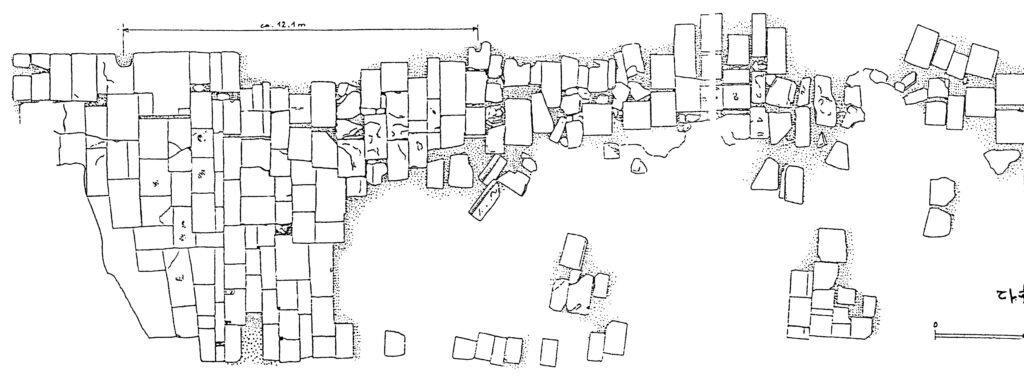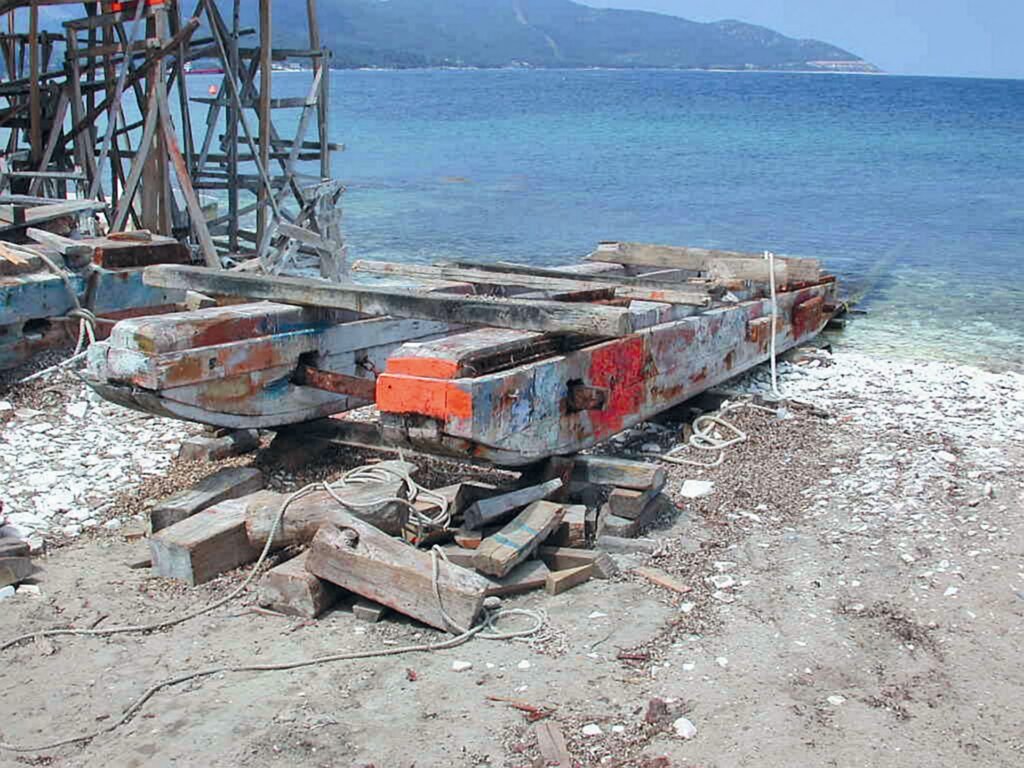Στον Δίολκο έχει διασωθεί μια λίθινη επιφάνεια, σε επαφή με τη θάλασσα (Εικ.1, 2).
Αποτελείται από εφαπτόμενους δόμους, χωρίς να συνδέονται μεταξύ τους με μεταλλικούς ή
άλλους συνδέσμους. Η άνω επιφάνεια αυτών, είναι συνήθως ορθογωνικής μορφής, με
διαστάσεις οι οποίες ποικίλουν. Δημιουργούν επίπεδο με κλίση προς τη θάλασσα. Σ’ αυτό το
επίπεδο -ράμπα ή γλίστρα- γινόταν η ανέλκυση ή καθέλκυση των πλοίων.
Τα πλοία τοποθετούνταν μέσα στη θάλασσα, στα λεγόμενα «Βάζα». Αυτά σύρονταν μαζί με
το πλοίο, στο κεκλιμένο επίπεδο (γλίστρα). Η θέση του σκάφους, όπως και της γλίστρας,
ήταν κάθετη στην ακτή και στην διαδρομή του Διόλκου. Το σύστημα σκάφους και «Βάζου»
το έσυραν πάνω στη λίθινη γλίστρα και το έβγαζαν από το νερό. Στη συνέχεια, μέσω
συνδυασμού σταθερών «εργατών» έστριβε κατά 90° και τελικώς έπαιρνε θέση παράλληλη με
τη διαδρομή του Διόλκου. Η στροφή αυτή γινόταν πάνω στα μετακινούμενα «Βάζα». Εδώ,
αξίζει να σημειωθεί ότι, κατά τη στροφή αναπτύσσονται μεγάλες δυνάμεις τριβής, για τον
περιορισμό των οποίων θα πρέπει να χρησιμοποιούνταν λιπαντικά. Οι «εργάτες» ήσαν
μπηγμένοι στο έδαφος, σε μόνιμες θέσεις. Το «σύστημα» λάμβανε θέση στην προέκταση του
Διόλκου. Η κατάληξη του Διόλκου, ήταν μία τοιχοδομή κατασκευασμένη από δόμους σε
σχήμα Π.
Η τοιχοδομή αυτή είχε ύψος Η=1,25, μήκος 24,50 μ. και πλάτος 6,10 μ. Έφερε δάπεδο σε όλο
το πλάτος και σε μήκος 18,70 μ. από το συνολικό των 24,50 μ. Στην τοιχοδομή αυτή
κατέληγε ο ολκός, ο οποίος είχε μήκος μέχρι 24,0 μέτρα.
Το μήκος του “Βάζου” δεν αντιστοιχούσε επακριβώς με το μήκος του ολκού, πιθανότατα να
εξείχε απ’ αυτό. Το σκάφος όμως τοποθετούνταν συμμετρικά ως προς αυτό. Εάν ληφθεί υπ’
όψη ότι η κατασκευή και η συντήρηση ενός ενιαίου «Βάζου» μήκους 24,0 μ. είναι πολύ
δαπανηρή και δύσκολη, είναι εύλογο να υποθέσουμε ότι θα υπήρχαν μικρότερου μήκους
«Βάζα», τα οποία θα μπορούσαν να τοποθετηθούν κατά παράταξη, ώστε να μας δώσουν το
συνολικό μήκος των 24,0 μ. Έτσι, τα 8,0 μ. είναι ένα λογικό μήκος για κάθε «Βάζο»
ξεχωριστά. Για το συνδυασμό τους θα έπρεπε οι κοινές επιφάνειες επαφής να έχουν
αντίστοιχη μορφή και να συνδέονται μεταξύ τους (Εικ.6).
Μετά την τοποθέτηση του “συστήματος” ήταν πλέον δυνατή η κίνηση του ολκού. Η κίνηση
θα έπρεπε να γίνεται με όσο το δυνατόν λιγότερα φορτία. Συνεπώς, εάν το «Βάζο» είχε
σημαντικό φορτίο θα έπρεπε να απομακρυνθεί. Απομάκρυναν έτσι το ένα δοκάρι στήριξης
από τη μια πλευρά του σκάφους, και, για να μην ανατραπεί το σκάφος το στήριζαν
προσωρινώς με δοκάρια από τον ολκό ή από το έδαφος. Στη συνέχεια, τοποθετούνταν ξύλινοι
τάκοι, οι οποίοι στηρίζονταν στο κατάστρωμα του ολκού. Οι τάκοι αυτοί είχαν διατομή
αντίστοιχη με το κέλυφος του σκάφους, ήταν μονοί ή διπλοί. Οι διπλοί τάκοι συνδέονταν
μεταξύ των με ξύλινους δοκούς. Τοποθετούνταν ανά 4-5 μέτρα, καλύπτοντας πλήρως το
μήκος του σκάφους και έτσι πετύχαιναν τη στήριξή του. Με τον ίδιο τρόπο, απομάκρυναν και
τη δεύτερη παράλληλη κύρια δοκό του «Βάζου» και τοποθετούσαν εκεί τάκους, οι οποίοι
στήριζαν και την άλλη πλευρά του σκάφους. Ο ολκός απαλλασσόταν, έτσι, από το σημαντικό
φορτίο του «Βάζου» και πλέον κινούνταν εύκολα. Αφού ο ολκός, μαζί με το σκάφος, διένυε
τη διαδρομή του Διόλκου, κατέληγε στη θάλασσα. Αντίστοιχη τοιχοδομή με ράμπα, σαν αυτή
η οποία έχει βρεθεί στον Κορινθιακό κόλπο και στη θέση Ποσειδωνία, μάλλον θα υπήρχε και
στον Σαρωνικό κόλπο, στον Σχοινούντα. Ο ολκός μαζί με το σκάφος θα κατέληγε σ’ αυτή
την τοιχοδομή, η οποία είχε περίπου τα ίδια μεγέθη με αυτήν του Κορινθιακού κόλπου.
Στην καθέλκυση, το σκάφος συρόταν με το «Βάζο» από τον ολκό το οποίο είχε τοποθετηθεί
με αντίστοιχο τρόπο με αυτόν που είχε αφαιρεθεί κατά την ανέλκυση του σκάφους.
Τραβώντας το «Βάζο», μεταφερόταν και το σκάφος εκτός του ολκού. Το τράβηγμα γινόταν
από τους «εργάτες», οι οποίοι βρίσκονταν σε σταθερή θέση, όπως σημειώνεται στο σχέδιο.
Στη συνέχεια, με προσεκτική χρήση άλλων «εργατών», το «Βάζο» έστριβε μαζί με το σκάφος
και τελικά λάμβανε θέση κάθετη προς την ακτή, κατ’ επέκταση του κεκλιμένου επιπέδου
(γλίστρα), το οποίο θα υπήρχε και στον Σαρωνικό κόλπο. Γλιστρώντας το πλοίο στο «Βάζο»,
αφού είχαν βγει τα πλαϊνά στηρίγματα, κατερχόταν από το κεκλιμένο επίπεδο στη θάλασσα.
Η στροφή του συστήματος «Βάζου-σκάφους» γινόταν με χρήση «εργατών», με τη βοήθεια
επιπλέον φαλαγγιών υπό μορφή εσχάρας. Τα φαλάγγια είχαν κάθετη διάταξη σε σχέση με το
σκάφος, και δημιουργούσαν πλευρές εξαγώνου στο τεταρτημόριο του κύκλου της κινήσεως.
Η αντίστοιχη τοιχοδομή και το κεκλιμένο επίπεδο (γλίστρα) στον Σαρωνικό κόλπο, δεν έχει
αποκαλυφθεί τουλάχιστον μέχρι σήμερα.
Να σημειωθεί ότι η κατάληξη του Διόλκου στον Σαρωνικό κόλπο μπορούσε να ήταν κάθετη
στην ακτή. Σε αυτή την περίπτωση το σύστημα τοιχοδομή – ράμπα θα ήταν πιο απλό από
αυτό του Κορινθιακού κόλπου.
Η τοιχοδομή, αποτελείται από τοίχους, πάχους d=0,60 μ. και ύψους h=1,25 μ. Κατά τον
αρχαιολόγο Ν. Βερδελή, ο οποίος ανέσκαψε τον Δίολκο, η κατασκευή της θα πρέπει να
χρονολογηθεί την περίοδο του Πελοποννησιακού πολέμου, και αποσκοπούσε στη μεταφορά
πολεμικών, κυρίως, πλοίων. Το μήκος της ανερχόταν σε 24,50 μ. Το ίδιο μήκος θα έπρεπε να
είχε και ο ολκός για να εισέρχεται ολόκληρος σ’ αυτήν (Εικ.10).
Το μήκος των 24,0 μ προέκυψε και από τον υπολογισμό των τμημάτων εντός της Σχολής
Μηχανικού. Εκεί υπήρχε δεύτερη σειρά από δόμους και η μεταξύ τους απόσταση μετρήθηκε
σε 0,70 μ. Απ’ αυτό το διάστημα και από την καμπυλότητα της διαδρομής, μπορούμε να
συμπεράνουμε ότι το μέγιστο μήκος του κινούμενου ολκού ήταν 24,0 μ. Το μήκος αυτό
κρίνεται αναγκαίο για πολεμικά πλοία, μήκους 36-40 μ., είναι όμως μεγάλο για μικρότερα
σκάφη. Θα έπρεπε λοιπόν, να υπήρχαν ολκοί με διαφορετικά μήκη. Αυτό μας κάνει να
υποθέσουμε την ύπαρξη μικροτέρων, οι οποίοι, όταν υπήρχε ανάγκη, θα μπορούσαν να
ενωθούν.
Βιβλιογραφία: “Ο ΔΙΟΛΚΟΣ ΣΤΟΝ ΙΣΘΜΟ ΤΗΣ ΚΟΡΙΝΘΟΥ” Απόστολος Ε.
Παπαφωτίου, Πολιτικός Μηχανικός Ε.Μ.Π. Προλογίζει ο καθηγητής Ε.Μ.Π. Θεοδόσιος Π.
Τάσιος.
Την ταινία “Δίολκος για 1500 χρόνια” μπορεί να την παρακολουθήσει κανείς στο:
https://youtu.be/n–mWBKwBDI
Δρ. Απόστολος Ε. Παπαφωτίου
Πολιτικός Μηχανικός Ε.Μ.Π.
Οικονομολόγος Ε.Κ.Π.Α.
THE DIOLKOS ON THE ISTHMUS OF CORINTH
CARGO TRANSPORT ON THE DIOLKOS
A stone pavement sloping into the sea has been preserved on the Diolkos (Fig. 1, 2). This is
made up of paving blocks in mutual contact, but not held together by metal cramps or other
ties. Their upper surfaces are usually orthogonal, of various sizes. They form a flat surface
sloping toward and into the sea. The shops were hauled out and launched on this surface
(ramp and slipway).
The ships were in the sea, lying on “vasa”. These were drawn out, together with the ship, on
the inclined plane (slipway). The ships, like the slipway, were oriented perpendicularly to the
shore and the course of the D. The system of ships hull and “vasa” was pulled up onto the
stone slipway and out of the water. Then, by means of a combination of fixed capstans it was
rotated through 90* and finally positioned parallel to the direction of the D. This turn was
made atop the moving “vasa”. It is worth noting here that great frictional forces develop
during the turn, and lubricants had to be used to overcome these. The capstans were sunk into
the ground, impermanent positions. The “system” took place on the extension of the D. The
D’s termination was a platform made up of paving blocks in a Π pattern.
This platform was H=1.25 m high and 24.50 m long and 6.10 m wide. It bore a dock
extending over its whole width and for 18.7 m out of its total length of 24.50 m. On this
platform role the carriage, this was up to 24 m long.
The length of the “vasa” did not correspond exactly to that of the carriage, but probably
exceeded it. But the hull was placed symmetrically upon them. Although the building and
maintenance of a single “vasa” 24 m long is quite expensive and difficult, we can suppose
that there were shorter Vasa that could have been placed in series, as to give a total length of
24 m . Thus 8.0 m is a reasonable length for each separate vasa. To hold them together, their
common surfaces between them must have had reciprocally cores pounding shapes and been
linked mutually together (Fig.6).
After the “system” was emplaced the carriages could move they would have carried the least
possible load. Consequently, if the vasa had a significant load, it would have to be removed.
Thus the one or more props supporting the ship on a side were removed and, to keep it from
toppling over, the ship was temporally supported by beams from the carriage on the ground.
Then wooden pieces were placed so as to support the deck of the carriage. These props had a
section face corresponding to the ship’s hull, and were single or double. The double props
were held together by wooden rots. They were placed spaced every 4-5 m along the sip’s
length and thus supported it. In the same way the second main beam of the vasa was removed.
Props supporting the ships other side were inserted. The carriage was thus freed of /from the
considerable weight of the vasa and thereafter moved more easily. After the carriage together
with the ship traveled the whole length of the D it arrived at the other sea. A corresponding
platform like that at Poseidonia on the Corinthian Gulf would have existed on the Saronic
Gulf also, at Skhoinous. The carriage and slip would have terminated their journey at that
platform, which would have had about the same size as that on the Corinthian Gulf.
In Launching, the ship was pulled with the Vasa off the carriages, which had been positioned
in an orientation corresponding to that when the carriages was hauled out. By drawing the
Vasa, the ships were transferred off the carriage. This was accomplished by the capstans,
which were strongly fixed in position, as indicated on the diagram. Then, with successive use
of other capstans, the Vasa were rotated along with the ship and finally took position
perpendicularly to the shore, on the extension of the inclined surface (slipway), which also
existed on the Saronic Gulf as well. Once the supporting props were removed from its sides,
the ship slid over the Vasa from the inclined slipway into the sea. The “ship-vasa” system was
rotated by means of capstans, and with the additional aid of rods arranged in the form of a
grid. The rods were perpendicular to the ship and formed the sides of a hexagon on the quarter
of the circle of movement. The corresponding platform and inclined plane (slipway) on the
Saronic Gulf have not been found so far.
It should be noted that the termination of the D on the Saronic Gulf may have been
perpendicular to the shorlone. If so, the platform – ramp system would have been simpler than
that on the Gulf of Corinth.
The platform is made up of paving blocks 0.60 m in thickness and 1.25 m in height.
According to the archeologist N. Verdelis, who excavated the D its building must be dated in
the period of the Peloponnesian War, and served for the transport of chiefly warships. Its
length was up to 24.50 m. The carriage should have had the same length in order to occupy it
fully (Fig.10).
The length of 24.00 m also emerges form measurements and calculations of the parts of the D
within the area of the Engineering school. Here was a second series of paving blocks, the
distances between them measuring 0.70 m. From this spacing and from the curvature of the
D’s course, we can inform that the greatest length of the moving carriage was 24.00 m. This
length seems necessary for ancient warships, which were 36-40 m long, but large for the
smaller vessels. Thus there may have been carriages of various lengths. This suggests there
may have been smaller ones, which if necessary could have been linked together in
continuation.
Bibliography: “THE DIOLKOS ON THE ISTHMUS OF CORINTH” by Apostolos E.
Papafotiou, Civil Engineer N.T.U.A. (National Technical University of Athens). Foreword by
Theodosius P. Tasios, Prof. at N.T.U.A. (National Technical University of Athens).
Animation film “Diolkos for 1500 years”: https://youtu.be/3GtE0kfWDuU
Dr. Apostolos E. Papafotiou
Civil Engineer N.T.U.A.
Economist N.K.U.A.
ΠΑΡΑΡΤΗΜΑ ΕΙΚΟΝΩΝ
Εικ.1: Κάτοψη της ράμπας-γλίστρας, στο στόμιο της διώρυγας στον Κορινθιακό κόλπο. Πηγή:
Walter Werner, Nautical Archeology 1997. – Fig.1: Plan of slipway-ramp at canal’s mouth on
Corinthian Gulf. Source: W. Werner, Nautical Archaeology, 1947.
Εικ.2: Ράμπα-γλίστρα στο στόμιο της διώρυγας προς τον Κορινθιακό κόλπο. Πηγή: Φωτογραφία
Απ. Παπαφωτίου. – Fig.2: Slipway-ramp at canal’s mouth on Corinthian Gulf. Source: Ap.
Papafotioυ҆ s photograph.
Εικ.3: Καρνάγιο στη νέα Ρόδα Χαλκιδικής – «Βάζο». Πηγή: Φωτογραφία Απ. Παπαφωτίου. – Fig.3:
Boatyard at Nea Roda, Chalcidice Peninsula, showing paired Vasa. Source: Ap. Papafotioυ҆ s
photograph.
Εικ.4: Πρόταση ανελκύσεως σκάφους από τη ράμπα και τοποθέτηση αυτού στον ολκό που υπάρχει
στην τοιχοδομή. Πηγή: Tony Kozelj, 2004. – Fig.4: Hypothetical diagram of hauling out of ship on
ramp and its placement on carriage awaiting on pavement of Diolkos. Source: Tony Kozelj, 2004.
KEY: 1) Sea, 2) Entrance to Corinthian Gulf.
Εικ.5: Πρόταση ανελκύσεως σκάφους από τον ολκό στην τοιχοδομή, και στη συνέχεια, στη
θάλασσα μέσω της ράμπας. Πηγή: Tony Kozelj, 2004. – Fig.5: Hypothesized lowering of ship from
carriage to pavement and its subsequent launching by way of slipway-ramp. Source: Tony Kozelj,
- KEY: 1) Sea, 2) Entrance to Corinthian Gulf.
Εικ.6: Ιδεατή αναπαράσταση μεταφοράς τριήρους σε διπλό ολκό και λεπτομέρειες ολκών. Πηγή:
Tony Kozelj, 2004. – Fig.6: Diagrammatic representation of transport of trireme on double carriage-
trucks and details of carriages. Source: Tony Kozelj, 2004.
Εικ.7: Μεταφορά σκάφους πάνω σε ολκό. Τομή μετά ενδεικτικών υψομέτρων. Πηγή: Tony Kozelj, - – Fig.7: Transport of ships on carriage, cross sections with heights indicated. Source: Tony
Kozelj, 2004.
Εικ.8: Καρνάγιο στη νέα Ρόδα Χαλκιδικής – «Βάζο». Πηγή: Φωτογραφία Απ. Παπαφωτίου. – Fig.8:
Boatyard at Nea Roda, Chalcidice, showing large paired Vasa and their joining and spacing.
Source: Ap. Papafotioυ҆ s photograph.
Εικ.9: Καρνάγιο στη νέα Ρόδα Χαλκιδικής. Πηγή: Φωτογραφία Απ. Παπαφωτίου. – Fig.9: Boatyard
at Nea Roda, Chalcidice, showing small caϊque of gaϊta type hauled out after removal of Vasa.
Source: Ap. Papafotioυ҆ s photograph.
Εικ.10: Τοιχοδομή στην άκρη του Διόλκου στον Κορινθιακό κόλπο. Φωτογραφία Ν. Βερδελής,
Αρχαιολογική Εταιρεία Ελλάδος. – Fig.10: Platform at Corinthian Gulf end of Diolkos. Photo by N.
Verdelis, Archaeological Society of Greece.
Εικ.11: Απόσπασμα από την ταινία “Δίολκος για 1500 χρόνια”. – Fig.11: Animation film “Diolkos
for 1500 years”.



